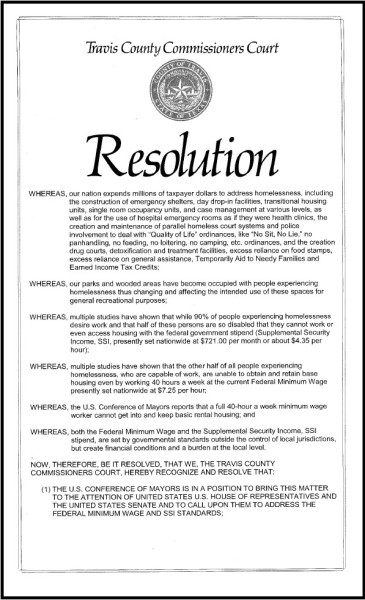
In December 2014, the Travis County Commissioners Court in Texas joined a growing number of Mayors who have endorsed similar Resolutions calling for the U.S. Congress to adopt the House the Homeless, Inc., three-pronged SOLUTION that will End and Prevent Economic Homelessness.
There are two Federal Standards causing Homelessness in the nation. According to the last several reports from the U.S. Conferences of Mayors, a full-time, minimum wage worker cannot get into and keep a one-bedroom apartment. This makes up fully 1/2 of the 3.5 million people who will again experience homelessness in the nation this year. The other half, who are so disabled that they cannot work, are eligible to receive federal disability benefits called Supplemental Security Income, or SSI. While the Federal Minimum is currently set at $7.25 per hour, and shown to leave full-time workers on our streets, the SSI stipend for those who cannot work equates to about $4.22 per hour, or a little more than half that failed amount.
The Resolution calls upon the U.S. Congress to:
1) Fix the Federal Minimum Wage so that a person working a 40 hour week will be able to afford basic food, clothing, and shelter (including utilities and transportation) wherever that work is done throughout the U.S.
2) Index the SSI stipend to the local cost of housing so that a person deemed disabled by the federal government can afford a roof over their head other than a bridge.
3) Embrace the Ethical Tenet: “Discharge No One Into Homelessness.” Our nation’s Institutions: hospitals, prisons, mental health facilities, jails, foster care facilities, U.S. military, etc., must devise plans to ensure that when people are discharged from their facilities (on time), they attain stable housing situations and are not discharged to our streets. (Sign the petition here.)
Note that there are already existing structures available to enact this proposal, as each institution is already equipped with a team of social workers.
This three-pronged Blue Print will end economic homelessness for over 1 million minimum wage workers and prevent it for all 20 million other minimum wage workers. Finally, the plan will prevent homelessness for anyone leaving one of our Institutions.
Presently, the financial cost of dealing with homelessness falls 100% to the shoulders of tax payers. This plan will reduce that burden on our Municipalities that currently sustain and deal with homelessness through the creation and maintenance of shelters, transitional housing units, the use and cost of our hospital emergency rooms as if they were health clinics, parallel court systems, and police diversion for the enforcement of “Quality of Life” ordinances. Other tax savings can come from the reduction of excessive reliance on food stamp supports and excess reliance on General Assistance, TANF and EITC as all will be reduced by 50% or, in the case of The Earned Income Tax Credit, done away with entirely. This could all be done if employers (who benefit from the labor of workers) were to pay a wage that at least pays these workers enough so they can afford a simple efficiency apartment (which is even less than even a one-bedroom apartment).
Additionally, it has been clearly shown (www.UniversalLivingWage.org) that by paying living wages business will benefit by stabilizing the workforce and by simultaneously stimulating both local and national economies through increased consumer activity.
Finally, by paying fair, living wages, we will spur on the housing construction industry both locally and nationally as we respond to the housing needs of people who will finally have enough income to rent efficiency apartments just as Henry Ford’s workers became able to afford to buy the cars they were making.
Let’s take Action to make America the strong, industrious country that we know it can be. Let’s put the “O” back into Opportunity.
Richard R. Troxell
President/CEO/Founder House the Homeless and the Universal Living Wage Campaign


